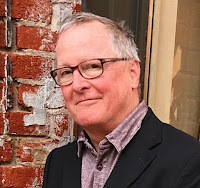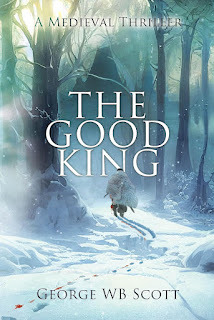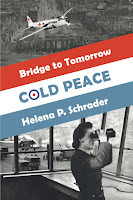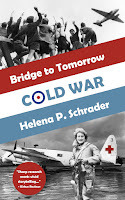Historical Figures in Historical Fiction - A Guest Entry from George WB Scott
George WB Scott was born in Stuart, Floridawhere he lived until he went to college in North Carolina. After graduation fromAppalachian State University, he went into television news in Tennessee and is now an independent video producer and writer, living in Knoxville with hiswife Mary Leidig. He has written a childhood memoir,"Growing Up In Eden," and two historical novels, "I Jonathan, aCharleston Tale of the Rebellion," and "The Good King, A MedievalThriller." He is currently workingon a novel set in Ohio, Texas, France and Florida during the first half of the20th century. Today he shares his insights on including historical figures into historical fiction.

NOT TRUE, BUT DEFINITELY NOT FAKE
"I pledge myself not to fakeanything."
This is a 1971 quote from renowned authorJames Michener in an interview by the Academy of Achievement. Michener is aninspiration to me, and to many writers. Historical fiction writers try to getit right, while building characters and situations to tell the author'sstories.
When I wrote "I Jonathan," myfirst historical novel, I spent more than a decade reading, studying, workingto get it right, not to "fake" anything.
The challenge as a writer is to put acharacter into a believable world based on facts, as best we can know them fromour vantage point. And we all come from "another where and when," aswe craft the story in another time. So we must do the best we can to faithfullyrecreate the world inhabited by our characters.
My book's main character is fictional. Hecomes from a different culture (New England and France) to the American Southduring the American Civil War. Jonathan very briefly encounters Robert E. Leein Charleston, in 1861. He was commander of the Southern forces aroundCharleston early in the war, and helped save some buildings during the greatfire. This is documented.
Vice President John C. Breckinridge appearson his presidential campaign, and other prominent people are at some point onthe scene. They are often peripheral characters whose presence would be hard toignore in those times. They did not drive the story, and are used more forauthentic atmosphere of the times than active elements.
Jonathan, foreign to this culture, is awitness from Boston to an ostensibly Christian society based on kindness andcharity, learning how it justifies holding thousands of fellow humans inpermanent and hereditary bondage. For profit. This is one of his conflicts, andI must build a credible world for him to interact with.
My research includes subjects that are notusually part of the popular mystique of the Old South—particularly the LowCountry. The book explores occupations of the hundreds of free Blacks in thetown, the Jewish population in Charleston, and the lives, work andentertainments of the common people. I include some individuals representingtypes or categories, such as a root doctor, a military observer in the belltower of St. Michael's Church, Irish merchants, workers and policemen, and ablockade-running sea captain who was patterned after an actual personality.These characters are often composites, with traits of multiple historicalcharacters.
As Jonathan meets historical figures likeU.S. Army Major Robert Anderson at Fort Sumter, the photographer George Cook,and Abner Doubleday who many readers will know as the "inventor ofbaseball (false)," he learns about Charleston and environs. These and thehistoric figures are the texture, the touchstones for the tale of a young mancoming to terms with his own beliefs, doubts and feelings.
Robert Smalls is also documented. He laterbecame a South Carolina legislator and is best known for his theft of the steamtransport "Planter." His actions give another fictional character onboard ship the platform to justify rebellion from his own family and enslavedsituation.
Clara Barton, who later founded theAmerican Red Cross, makes a fleeting appearance across a beach after a terriblebattle where she actually tended U.S. troops. She and a fictional nurse fromthe opposing side share a distant, silent wave and lend Jonathan a moment toreflect on a feminine view of the folly of men.
Some scenes are drawn from history,especially from Mary Chesnut's invaluable "A Diary from Dixie," andfrom historical records, such as the bombardment of Fort Sumter by the UnionNavy, and battles of Secessionville and Battery Wagner. One social party is myre-creation of an event that was attended by Mrs. Chesnut. Maimed officers inattendance are commented on by young women watching their men diminished by thethen-current "unpleasantness" of war. "Oh, he has his eye outfor you," and of a one-armed soldier, "He is going to ask for yourhand."
Building a story around the dramatic eventsof a well-documented series of events such as Civil War Charleston can be anadvantage. The writer can "hang the story on the bones of history,"as the expression puts it. Indeed, much of my inspiration came from amicrofiche film of The Charleston Courier newspaper held in the library of theUniversity of Tennessee.
My second historical novel is verydifferent, as the history in 10-century Bohemia is decidedly less detailed. Ina way this is very liberating, as I can use the few historical elements tocreate an almost wholly fictional story employing the very few facts we know ofthat time and place.
"Good King Wenceslas" is afavorite Christmas song about a little-known saint and leader of ancientPrague. His basic story is one of grace, with a tragic end. The historicalcharacters offer a mostly blank slate. I based the novel on chronicles andlegends of a beatific figure who performed acts of kindness and even miracles.His younger brother is almost wholly unknown except for the castles andchurches he built, and that he cold-bloodily murdered his older sibling. Theyboth were children of a totally evil pagan princess, whose grasping claim topower drove her to do any vile thing to regain it. The brothers are also thegrandchildren of the very real Saint Ludmila, a pivotal figure who broughtadvanced agriculture and Christianity to their country.
With these historic people and a fewdisembodied names associated with the legends, I discovered a basic story andstock of characters I could mold into a plausible drama. I researched Slavicpagan religions, academic archeology and anthropology, folk tales, and elementsof more modern traditional Czech life. I built these into a stew of palaceintrigue and internal conflict. Finally it developed into a coherent story witha resolution, or at least the striving toward one. Such was my goal.
Much of my research involveshistories—books and articles, and there is a great range of readability. I'vealways loved history, and know that even some famous writers may put lots ofinformation into exciting narratives. And many simply provide lots of information.Writers like Eric Larson can take mundane events around a dramatic happeningand craft riveting accounts. Barbara Tuchman gave us medieval Europe through aflashing prospect. Others may do exhaustive research on a president or otherimportant person and compose a manuscript, a trough of molasses that the readermust slog through, held between the covers of a book.
My own great-uncle Lawrence Schoonoverwrote historical fiction that mostly upheld the goals of Michener, "not tofake," but built new stories, novels, based on the real, on kings andpashas, queens and heroes. Historical facts are served as side items on agleaming platter of a savory main course.
C.S. Forester wrote the thrilling HoratioHornblower series and took us into the world of sailing ships of the Napoleonicera. Admiral Nelson, as I recall, made only a brief appearance. His are newstories, solidly based on the naval publications of the period—real events.
Even writers of fantasy must have someidentifiable framework to build on. J.R.R. Tolkien's wonderful world of MiddleEarth is solidly based on European legends and epics, as well as those of theMiddle East. His works even have elements of Biblical, Native American, FarEastern and African traditions. Frank Herbert's "Dune" series has thevibes of palace intrigue from medieval European royal courts.
I love Michener because he was unafraid totackle the big issues, the big stories. And he wrote so many by telling thelittle stories, the ones of the people peripheral to the main event. Hischaracters surround the larger historical figure of the king, or the general,the chief, the emperor. We learn much by listening in the head of the servingboy, the concubine, or the soldier, where we see the trials of the time throughhis more personal experiences. I first read "Hawaii" when I was aboutfourteen, and I was hooked. Historical fiction! And hundreds, thousands writein that genre. Worlds to discover!
Novels are, by their very name, "newstories," so the reader expects that all aspects are not "true."But in the words of Michener, good historical novels are "not fake."
I use old newspapers for background when Ican. I particularly like "Chronicling America" Library of Congresswebsite. The "LOC" has historical maps for geographical references.Interlibrary loan is also valuable. Go online and discover what you can findthrough your local library.
So, to writers of historical fiction, theobvious advice from the masters is: do your research, verify your facts, andcreate your own (new) story.
Your historical novel—your new story—canbe, if not quite true, definitely not fake!
 Find out more about George at: https://www.amazon.com/stores/author/...
Find out more about George at: https://www.amazon.com/stores/author/...
Blog Host, Helena P. Schrader, is the author of
the Bridge to Tomorrow Trilogy.
The first two volumes are available now, the third Volume will be released later this year.

The first battle of the Cold War is about to begin....
Berlin 1948. In the ruins ofHitler’s capital, former RAF officers, a woman pilot, and the victim of Russianbrutality form an air ambulance company. But the West is on a collision coursewith Stalin’s aggression and Berlin is about to become a flashpoint. World WarThree is only a misstep away. Buy Now
Berlin is under siege. More than twomillion civilians must be supplied by air -- or surrender to Stalin's oppression.
USAF Captain J.B. Baronowsky and RAF FlightLieutenant Kit Moran once risked their lives to drop high explosives on Berlin.They are about to deliver milk, flour and children’s shoes instead. Meanwhile,two women pilots are flying an air ambulance that carries malnourished andabandoned children to freedom in the West. Until General Winter deploys on theside of Russia. Buy now!
Based on historical events, award-winning and best-selling novelistHelena P. Schrader delivers an insightful, exciting and moving tale about howformer enemies became friends in the face of Russian aggression — and how closethe Berlin Airlift came to failing.
Winning a war with milk, coal and candy!



